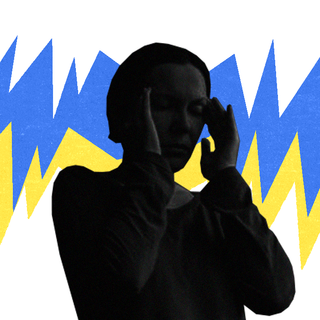
Inside India’s Mental Health Institutions, Women Lose Autonomy and Agency
Families often “discard” women whose mental illness becomes too burdensome, leaving them trapped in institutions without agency.

A woman in a neatly ironed, crisply starched, bright-pink saree coyly introduces herself as Jasmine. Perched above her right ear, three fresh roses adorn her hair, with her wrists tinkling with glass bangles of all colors. She is all smiles as she talks about herself, her friends, and gossips about a fight that has just taken place in a ward close by. We are ensconced deep inside the high and imposing walls of the Kilpauk Institute of Mental Health, Chennai. Jasmine meets me at the industrial training center (ITC), where many women learn vocational skills. Around us, a few women quietly concentrate on weaving baskets; some are bent over the fabric and sewing needles, making purses. Jasmine is chatty. She is from Maharashtra and speaks a curious mix of Urdu and Tamil.
Noting her general air of enthusiasm, I ask, “How long have you been here?”
“Twenty years,” she replies.
***
Jasmine is one of several institutionalized women who stay indefinitely within India’s mental health care system once they enter. A Hans Foundation report showed that more women than men make up the long-stay population of mental health institutions. Leaving it is not an option that many have the luxury of exercising. In several cases, families often abandon them in institutions like these, not wanting anything more to do with them. And leaving of one’s own volition is extraordinarily difficult. From an institutional standpoint, questions that stand in the way are: Where would she go? What would she do? How will she be safe?
“We have a huge trust deficit in women’s capacities,” notes Ratnaboli Ray, the founder of Anjali, an organization in West Bengal aimed at deinstitutionalizing mental health.
By all appearances, Jasmine is well enough to work and care for herself. “I have nobody for me outside,” she says. Many women, like her, have no ties left to their previous lives.
“They are happy here,” says C*, a matron of the women’s wards. Indeed, the staff and some of the patients appear to share a rapport of familiarity and comfort. Life inside the airy and spacious campus seems to be better than whatever awaits them back in their natal or marital homes. Often, women come in escaping family trauma and violence that they don’t wish to return to.
Related on The Swaddle:
It’s Time for a More Humane Approach to Mental Health Care
However, not everything is as rosy. Many other women don’t enjoy unrestricted mobility even inside the campus. Tamizh, a staff member, showed me around all the wards in the women’s section of the in-patient department. As we walked through each, sometimes having to nearly step over people who lay half-undressed on the ground, we would encounter a few enclosures that were locked, with women holding on to the bars and asking Tamizh for various things. One such woman wanted a skipping rope; she was tired and exceedingly bored. Sensing that I was a visitor, she shouted to me just as I was leaving her line of sight from behind bars: “I have been here for seven years!”
The desperation in her voice was unsettling.
Another woman with close-cropped hair and a neat, floral nightie approached me while I waited for my guide. “Don’t be afraid of us,” she whispered. I told her I wasn’t. “We were well educated. We were like you once.”
The woman, who did not wish to be named, accompanied us through the rest of the walk. At one point, we passed by two people who looked a little too young to be here, in the adult women’s ward. I asked Tamizh who they were.
“They’re sisters. Their mother tortured them a lot,” she said. “So they killed her.”
***
How is agency defined, and whom can it be exercised against? According to the doctors and the wardens at Kilpauk, many women had been admitted for their defiance.
However, mental health institutions are not solely responsible for eroding the agency and rights of women. “If you deviate from what is expected of you due to your gender, you might experience violence. If you experience violence, you might experience impacted mental health. This is rooted in patriarchy and structural issues,” Saisha Manan explains from the Mariwala Health Initiative. The experience of violence, especially gender-based violence, cannot be separated from mental health issues.
In other words, sometimes women’s response to socially oppressive conditions, that last straw that tips the balance into a breakdown or an outburst, is the straw that breaks the camel’s back.
“We’re made to believe that [mental health institutions] serve purposes of healing, care, restoration, rehabilitation, but we hear similar things about prison systems,” Manan says.
“They’re also created to deal with what we deem as “deviance” — by the law and social norms, which inform one another.”
Indeed, psychiatric institutions are remnants of asylums set up in the 1800s as centers of “moral treatment” for the “deviant” who were deemed insane. Ethnographic research suggests that these facilities serve to house the castaways far from society as “anonymized individuals… under the gaze, remit, and rules of an oppressive regime.” In India, there is a colonial history underpinning institutionalization of mental health: standards of care differed according to social class, and racial prejudice differentiated the Western mind from the “native” one.
When the Mental Health Act of 1987 replaced the colonial Indian Lunacy Act of 1912, things improved. Still, numerous reports have highlighted the human rights violations inside mental health institutes. Most recently, the Supreme Court emphasized the plight of women in such facilities and urged state governments to take measures to improve the same.
The problem also arises because help-seeking behavior is not encouraged in women. Often, mental health issues escalate out of hand before women are provided the attention and care they need — by which time, it can often be too late for them to exercise independent agency over healthcare decisions.
Dr. Devi from the Kilpauk institution explains that as long as women maintain their abilities to cook, clean, and perform household chores, they are not allowed to seek treatment. When they are unable to perform these tasks, families take them to institutions and leave them there.
“Decisions on mental healthcare treatment include the decisions made by caregivers and not just by the person with lived experience. Any deviance from the norm for a woman, such as not being able to cook, clean, or be ‘functional’ is seen as the reason to seek help. The way ‘functionality’ is defined is the lack of ability to take care of others rather than taking care of herself,” explains Jasmine Kalha, from the Centre for Mental Health Law and Policy.
Related on The Swaddle: Tell Me More:
Talking Mental Health Policy and Media Reportage With Dr. Soumitra Pathare
At this stage, many women lose their decision-making rights, which are transferred to caregivers or institutions.
Along with decision-making, patients’ rights to liberty are also taken away. “There is no space to express your choice, wishes, desires; every wish and desire is psychiatristized,” says Ray.
“It’s a strange space of being in this closed atmosphere with no access to the real world, where you’re left to the mercy of some people being more powerful than others. It’s a bit like society being played out, a microcosm of the macrocosm,” Kalha adds.
Inside these institutions, the progress of these women is viewed through the lens of “recovery versus non-recovery” — even though recovery is never linear. When families don’t immediately abandon them, how they define recovery depends on how long women stay in institutions. But the patients are never afforded the right to self-determine what recovery means to them. Even if, clinically speaking, women “recover,” families often refuse to take them back due to stigma and a sense that they are no longer useful or “beautiful,” according to Dr. Devi. As a result, institutions are compelled to send women to shelter homes or keep them even after recovering. The decision of where to go, however, is hardly ever the woman’s to make.
But a paradox arises.
“You can prove someone is not well, but you can’t prove they’re now well. The stigma and discrimination of a label continues to stay for life,” Kalha points out. Often, the absence of outward symptoms is not enough to declare that someone has recovered.
***
This “recovery” fallacy leads to many women being kept inside institutions for a long time, with no clear markers for complete recovery. Dr. Devi explains that although institutions try to get patients to a point where they can leave, things get murky when recovery is a factor of compliance and non-deviance. “Aggression,” for instance, is a symptom that prevents hospitals from allowing patients to discharge themselves.
“Sometimes, it is a criterion to retain them — it is a major thing that caregivers struggle with. If they’re aggressive, we won’t send them home. Some patients go through highs and lows while working here. During those times, they can be aggressive,” Dr. Devi explains. Further, when patients’ desire to leave is debited, they become “aggressive” and get put down with injections.
It’s important to note here that aggression is defined differently in women. Social suffering is often pathologized as “aggression,” and the benchmark for men is very different. Laboni Roy, from Iswar Sankalpa, a Kolkata-based organization that works on deinstitutionalizing mental health, says that physical aggression is pathologized more in women than men. Kalha and Ray agree: anything that deviates from docility and quiet obedience in women is marked as aggression. Gender roles prescribe aggression as a marker of masculinity. As a result, women could be declared aggressive for behavior that wouldn’t be labeled the same way for men.
In her twenty years of advocacy, Ray explains that she has come across several instances where even the desire to wear jeans and skirts was pathologized in women, who were then reprimanded or even punished with injections.
“It’s effortless to categorize women as violent — if they question the nurses or say ‘I will not abide by what you’re saying,’ it is seen as violence.”
The gendered paradigm of recovery within institutions shows a fragile line separating the mentally ill from the incarcerated in the gaze of the state. The emphasis on “calming” aggression before releasing someone from confinement has a disciplinary bent to it. Indeed: “the entire structure of institutionalization in our country is still borrowed heavily from the criminal justice system. There are wards, there is a ward master… there are grilles, there are locks, there are meshes,” Ray points out.
What separates the institutionalized from those who aren’t is the perception of what “normal” people should look and behave like. Adhering to these norms comes with the privilege of dignity. For many without access to support structures and resources, this compliance is not an option. In a parallel universe, “abnormal” could be any one of us.
This article is the first of a two-part piece on women in mental health institutions in India.
Rohitha Naraharisetty is a Senior Associate Editor at The Swaddle. She writes about the intersection of gender, caste, social movements, and pop culture. She can be found on Instagram at @rohitha_97 or on Twitter at @romimacaronii.
Related


Alarming New Study Finds Baby Poop Is Loaded With Microplastics
